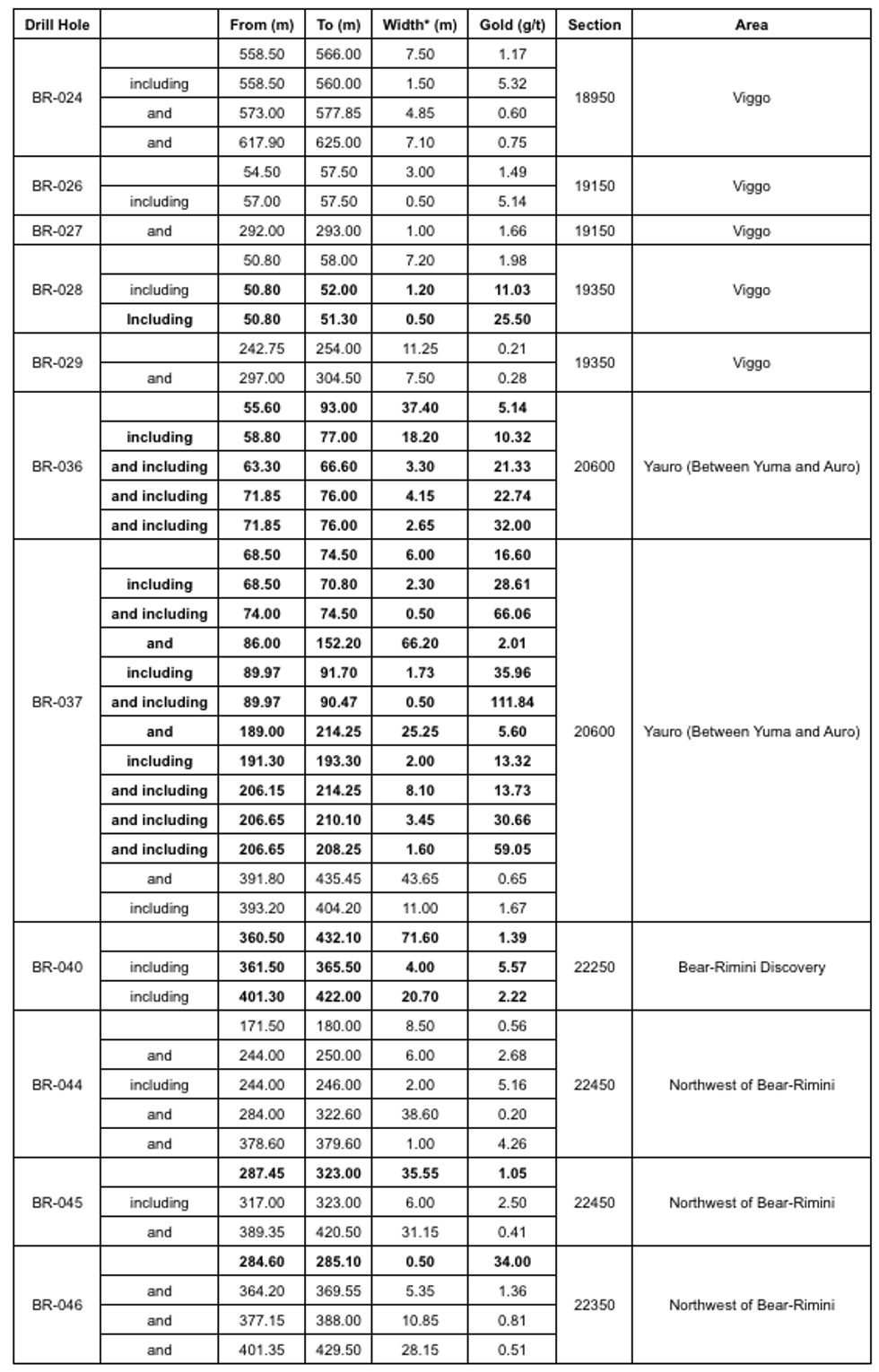Great Bear Drills New Near-Surface High-Grade “Yauro Zone” Discovery at Dixie

Great Bear Resources Ltd. reported new results from its 90,000 metre drill program at its 100% owned Dixie project in the Red Lake district of Ontario.
Great Bear Resources Ltd. (the “Company” or “Great Bear”) (TSXV:GBR) today reported new results from its ongoing, fully-funded 90,000 metre drill program at its 100% owned Dixie project in the Red Lake district of Ontario. Three new gold discoveries have been made and drill results disclosed in this news release are from the following zones along the LP Fault: Yauro (new zone), Viggo (new zone), Bear-Rimini, Northwest of Bear Rimini; and along the North Fault (new zone), which runs parallel to the LP Fault. Highlights include:
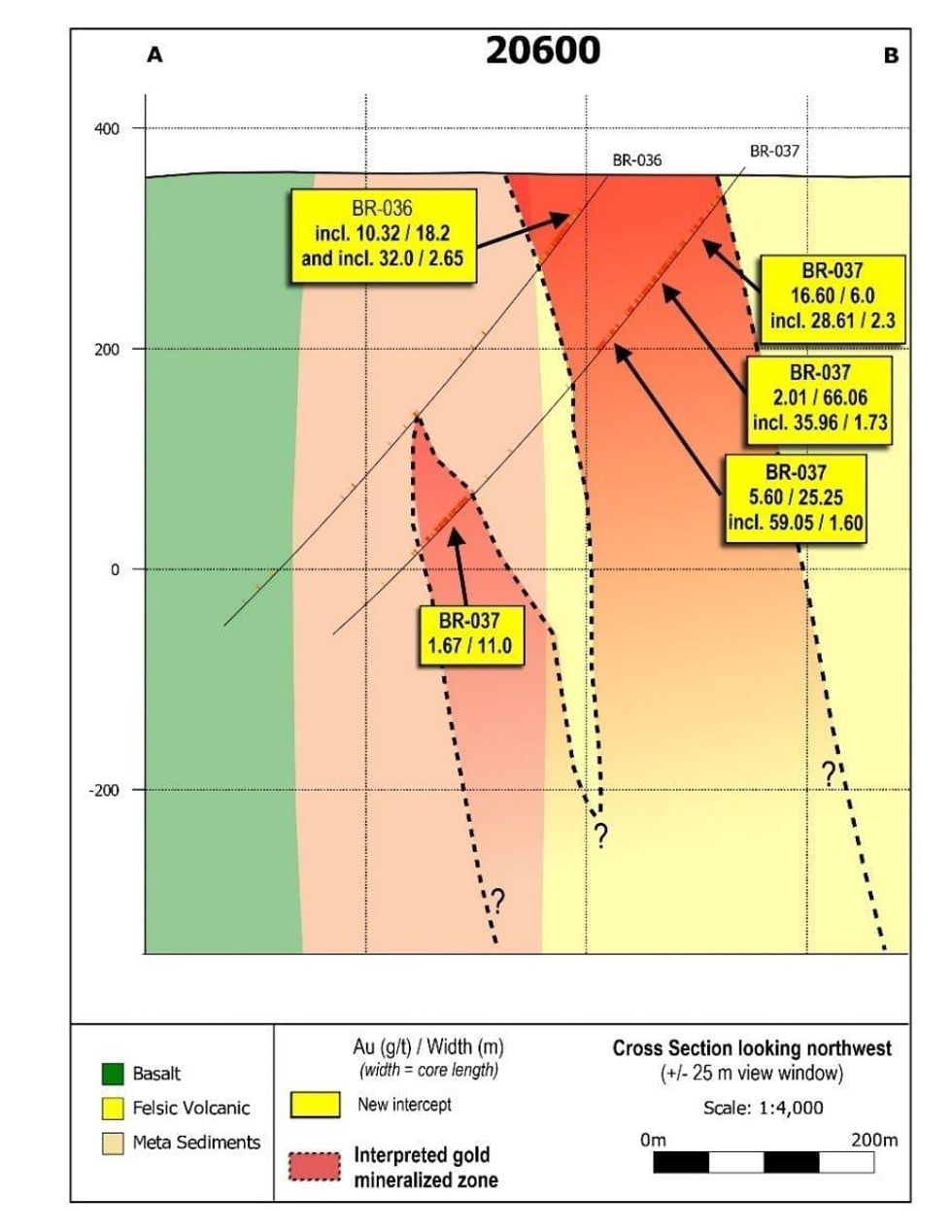
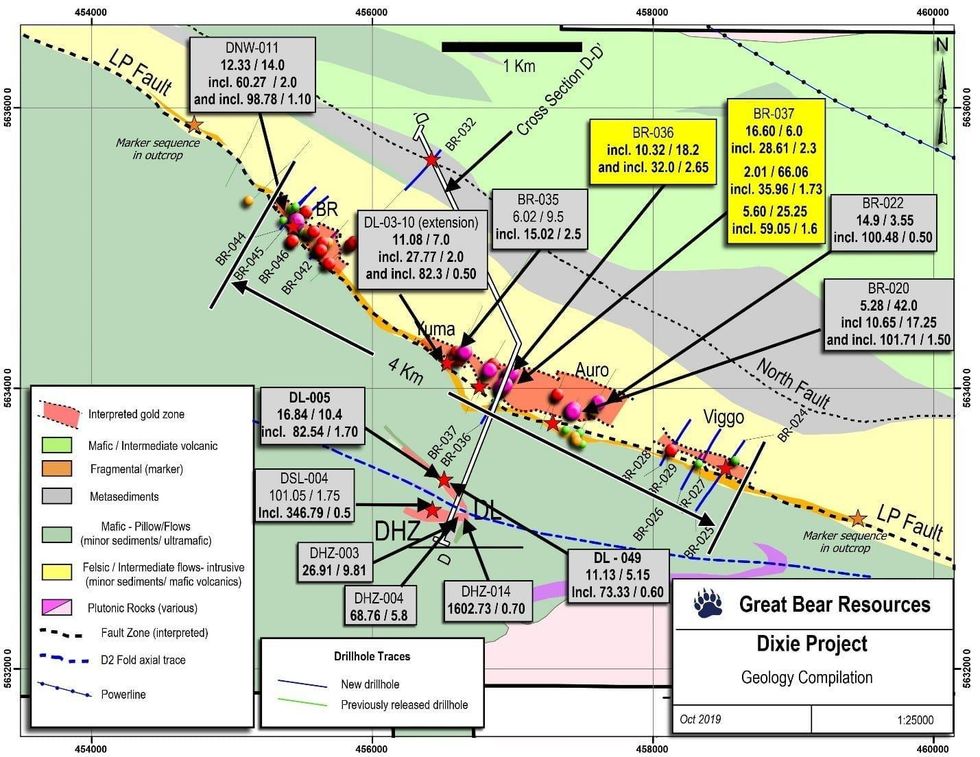

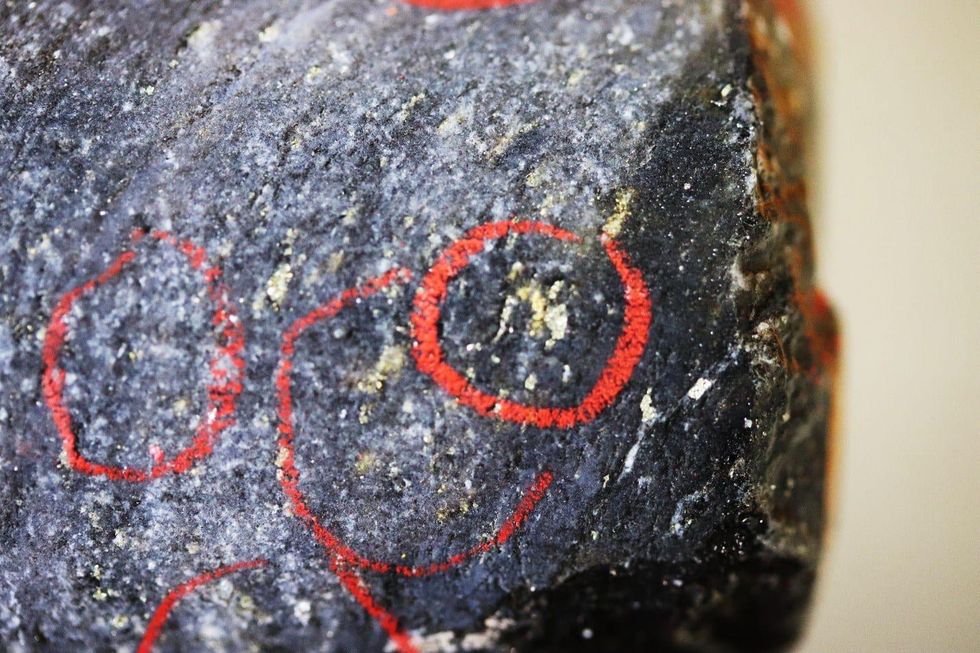
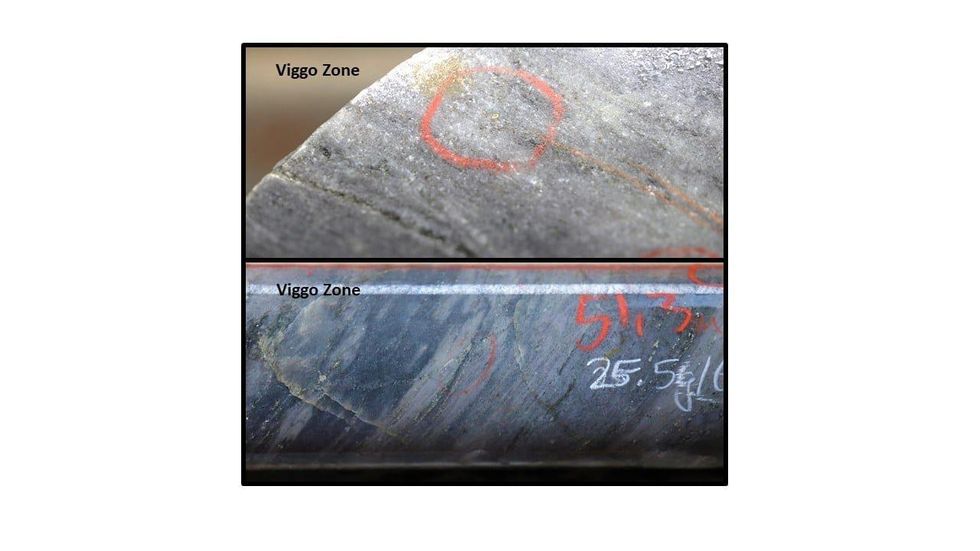
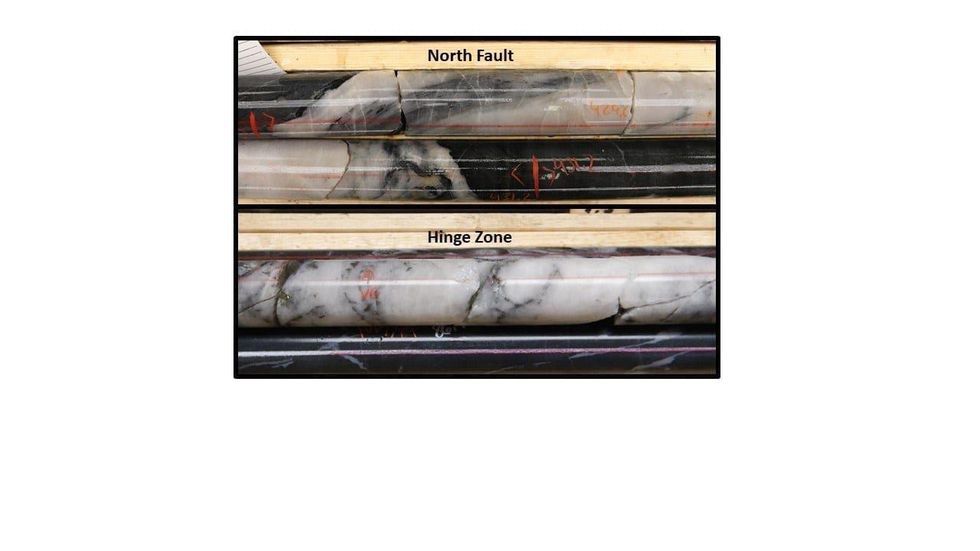
- The new “Yauro Zone” is located between the Yuma and Auro discoveries along the LP Fault. A significant structural dilation has localized multiple high-grade gold mineralized intervals. Assay results are shown in Table 1.
- The Yauro Zone consists of several gold intervals spanning two drill holes collared 125 metres apart, with intervals of mineralization observed over 300 metres of apparent width, as shown in cross section on Figure 1.
- Results include: 32.00 g/t gold over 2.65 metres and 21.33 g/t gold over 3.30 metres, within a wider interval of 5.14 g/t gold over 37.40 metres; 30.66 g/t gold over 3.45 metres, within a wider interval of 5.60 g/t gold over 25.25 metres; and 35.96 g/t gold over 1.73 metres, within a wider interval of 2.01 g/t gold over 66.20 metres.
- Gold mineralization extends to within metres of surface in both discovery drill holes.
- The gold system at Yauro appears to increase in apparent width and number of gold intervals with increasing depth. This pattern is observed in most areas drilled to-date along the LP Fault.
- The zone occurs near an inflection point in the LP Fault system, where the strike direction of the main structure changes. This is also a critical gold control at other large Archean gold deposits.
- Drilling one kilometre southeast of the Auro Zone in the new “Viggo Zone” has extended the LP Fault gold mineralized system to 4 kilometres of strike length, which remains open to extension.
- The first drill hole testing the “North Fault” has intersected Hinge Zone style gold-bearing quartz veins. Follow-up drilling will test this new 18 kilometre long target which parallels the LP Fault.
Table 1: Most recent results from drilling along 4 kilometres of the LP Fault target.
*Widths are drill indicated core length, as insufficient drilling has been undertaken to determine true widths at this time. Average grades are calculated with un-capped gold assays, as insufficient drilling has been completed to determine capping levels for higher grade gold intercepts. Average widths are calculated using a 0.10 g/t gold cut-off grade with < 3 m of internal dilution of zero grade.
Chris Taylor, President and CEO of Great Bear said, “The new high grade Yauro discovery occurs within a predicted zone of increased structural dilation between the Yuma and Auro discoveries, and is coincident with one of the recently identified geochemical (SGH) anomalies. I would encourage investors to refer to the cross sections provided in Figures 1, 2 and 3 to gain context. The LP Fault discovery including the Yauro zone are not typical of vein-hosted Red Lake style gold deposits, but are flanked to the north and south by Red Lake style gold-bearing veins at the Hinge/Limb and new North Fault discoveries. Two drill holes collared 125 metres apart were required to cross what we interpret as a major dilatancy or “blow” along the LP Fault at Yauro. Finding something this large and high-grade within metres of the surface is one of the most important discoveries on the project to-date. And like other areas of the LP Fault, the high-grade is flanked by wide intervals of moderate grade gold mineralization that could be very important for the project as it progress to more advanced stages.”
Yauro Zone Discovery Along LP Fault
The new Yauro Zone discovery is located half way between the Yuma and Auro Zones along the LP Fault 380 metres to the southeast of the Yuma Zone discovery, and 390 metres to the northwest of the Auro Zone discovery. The Yauro Zone occurs near a deflection point in the trend of the LP Fault, as shown on Figure 2. The LP Fault trends more northwesterly to the west of Yauro, and more east-westerly to the east of Yauro.
This discovery marks the largest apparent concentration of near-surface high-grade gold intersected at the Dixie property to-date. The relationship between the Yauro Zone, LP Fault, Dixie Limb and Hinge Zones is shown in cross section on Figure 3. Coarse visible gold was observed in several intervals at the Yauro Zone, as shown on Figure 4.
Oriented structural data collected during drilling shows that the Yauro Zone trends northwest to southeast, parallel to the LP Fault. Discovery holes BR-036 and BR-037 were drilled towards the southwest, at right angles to the mineralized trend.
Extension of LP Fault Gold System to 4 Kilometres of Strike Length:
The Company continues to step-out systematically along strike of the LP Fault to the east.
- A series of three reconnaissance drill fences spaced 200 metres apart with a total of 5 drill holes were completed approximately one kilometre to the southeast of the Auro Zone along the projected trace of the LP Fault, in the “Viggo Zone” area.
- All drill holes encountered the expected LP Fault related deformation and gold mineralization, including visible gold in 4 of the 5 holes and the associated quartz-sericite-albite-sulfide mineralization that is seen elsewhere along the LP Fault. An example of the observed visible gold mineralization is shown on Figure 5.
- Prior to drilling, high resolution airborne geophysics suggested the favorable host rocks could be thinner at surface in this location. Drilling confirmed this, and also detected increased strength and width of gold mineralization, alteration and marker horizon thickness at depth, and to the southeast of the Viggo Zone.
- Follow-up drilling will be undertaken below the initial reconnaissance holes, and farther along strike of the LP Fault, where the marker metasedimentary sequence has been mapped at surface approximately 1.3 kilometres to the southeast of this area.
New “Hinge Zone” Style Gold Veins Drilled at North Fault:
A single test drill hole, BR-032, was completed across the North Fault, which is a major geophysical lineament that parallels the LP Fault for over 18 kilometres of strike length, up to 1.2 kilometres to the north of the LP Fault. The drill hole discovered gold-bearing quartz veins similar to those observed at the Hinge Zone within 3 metres of the projection of the North Fault, as shown on Figure 6.
The main quartz vein assayed 1.39 g/t gold over 2.70 metres with an individual assay of 2.32 g/t over 0.50 metres. Of note, the vein was hosted by similar mafic volcanic units to those observed at the Hinge Zone. The location of the North Fault gold vein drill intercept is also shown in cross section of Figure 3.
Chris Taylor said, “This was a surprising result, and has the potential to become a significant discovery, since this target is over 18 kilometres long and is well defined geophysically. Prior to drilling, we had expected to see another deformation zone like the LP Fault, but instead the drill hole intersected minimally sheared rocks with gold mineralized quartz veins similar to the Hinge Zone, hosted by similar mafic volcanic rocks to those we see at Hinge Zone and Dixie Limb. At both the Hinge and Dixie Limb zones, high-grade gold is concentrated in steeply-plunging zones within the quartz veins. We now need to complete a grid of test holes along the North Fault to determine if such concentrations exist there as well, and what their orientations and spatial distributions are.”
Follow-up drilling will be carried out along the North Fault during the winter 2019 to 2020 drill program.
About Ongoing Exploration
Approximately 18,000 metres remain to be drilled in the Company’s current fully-funded 90,000 metre drill program. Three drill rigs are currently active at the Dixie project.
Great Bear’s exploration team has observed gold mineralization to be largely continuous over several kilometres of the LP Fault, including between the Bear-Rimini, Yuma, Yauro, Auro and Viggo discoveries, and is currently completing drill fences between already drilled areas to establish continuity. The Company will continue to undertake widely spaced reconnaissance step-out drilling along the LP Fault until the limits of the gold mineralized system are reached.
Sub-zone names like Bear-Rimini and Yauro will continue to be utilized to communicate where discoveries and ongoing drilling occur. The LP Fault is a geophysically-defined target that extends along approximately 18.5 kilometres of strike length at the Dixie property. 4 kilometres of this strike length have been tested to date, with gold observed and/or detected in all drill holes that have successfully intersected the structure.
A number of additional regional targets outside of the LP Fault also have yet to be tested across the property, including regional D2 fold axes such as that which hosts the Hinge Zone, and Soil Geochemical Hydrocarbon survey targets which were disclosed by the Company on October 10, 2019.
Webinar to Discuss Exploration Progress
A webinar will take place on Wednesday, November 6th at 4:05 pm EST/ 1:05 pm PST where Chris Taylor will update shareholders on the Company’s recent progress. Chris will be available to answer questions following the presentation. Online registration and participation details may be found at the following link:
https://attendee.gotowebinar.com/register/3742057385783291395?source=GBR
For those unable to participate, a recording of the webinar will be posted to the Company’s web site following the live broadcast.
About Great Bear
Great Bear Resources Ltd. (TSX-V: GBR) is a well-financed company based in Vancouver, Canada, managed by a team with a track record of success in the mineral exploration sector. Great Bear holds a 100% interest in its flagship Dixie property, which is road accessible year-round via Highway 105, a 15 minute drive from downtown Red Lake, Ontario. The Red Lake mining district is one of the premier mining districts in Canada, benefitting from major active mining operations including the Red Lake Gold Mine of Newmont Goldcorp Corp., plus modern infrastructure and a skilled workforce. Production from the Red Lake district does not necessarily reflect the mineralization that may, or may not be hosted on the Company’s Dixie property.
The Dixie property hosts different styles of gold mineralization. High-grade gold-bearing quartz veins and silica-sulphide replacement zones hosted by mafic volcanic rocks, and localized near regional-scale D2 folds occur at the Dixie Limb and Hinge Zones. These mineralization styles are also typical of the significant mined deposits of the Red Lake district.
The LP Fault is large a trans-crustal deformation zone that is interpreted to traverse the Dixie property for approximately 20 kilometres of strike length and has been drilled along 4.0 kilometres of strike length to-date. It hosts high-grade gold mineralization that is controlled by structural and geological contacts, and low to moderate grade disseminated gold that surrounds and flanks the high-grade intervals. The dominant gold-hosting stratigraphy consists of felsic sediments and volcanic units.
In addition, Great Bear is also earning a 100% royalty-free interest in the Pakwash, Dedee and Sobel properties, which cover regionally significant gold-controlling structures and prospective geology. All of Great Bear’s Red Lake projects are accessible year-round through existing roads.
Drill core is logged and sampled in a secure core storage facility located in Red Lake Ontario. Core samples from the program are cut in half, using a diamond cutting saw, and are sent to SGS Canada Inc. in Red Lake, Ontario, and Activation Laboratories in Ontario, both of which are accredited mineral analysis laboratories, for analysis. All samples are analysed for gold using standard Fire Assay-AA techniques. Samples returning over 10.0 g/t gold are analysed utilizing standard Fire Assay-Gravimetric methods. Pulps from approximately 5% of the gold mineralized samples are submitted for check analysis to a second lab. Selected samples are also chosen for duplicate assay from the coarse reject of the original sample. Selected samples with visible gold are also analyzed with a standard 1 kg metallic screen fire assay. Certified gold reference standards, blanks and field duplicates are routinely inserted into the sample stream, as part of Great Bear’s quality control/quality assurance program (QAQC). No QAQC issues were noted with the results reported herein.
Mr. R. Bob Singh, P.Geo, Director and VP Exploration, and Ms. Andrea Diakow P.Geo, Exploration Manager for Great Bear are the Qualified Persons as defined by National Instrument 43-101 responsible for the accuracy of technical information contained in this news release.
For further information please contact Mr. Chris Taylor, P.Geo, President and CEO at 604-646-8354, or Mr. Knox Henderson, Investor Relations, at 604-551-2360.
ON BEHALF OF THE BOARD
“Chris Taylor”
Chris Taylor, President and CEO
Neither TSX Venture Exchange nor its Regulation Services Provider (as that term is defined in the policies of the TSX Venture Exchange) accepts responsibility for the adequacy or accuracy of this release.
This new release may contain forward-looking statements. These statements are based on current expectations and assumptions that are subject to risks and uncertainties. Actual results could differ materially because of factors discussed in the management discussion and analysis section of our interim and most recent annual financial statement or other reports and filings with the TSX Venture Exchange and applicable Canadian securities regulations. We do not assume any obligation to update any forward-looking statements.
Click here to connect with Great Bear Resources (TSXV:GBR, OTC:GTBDF) for an Investor Presentation.
